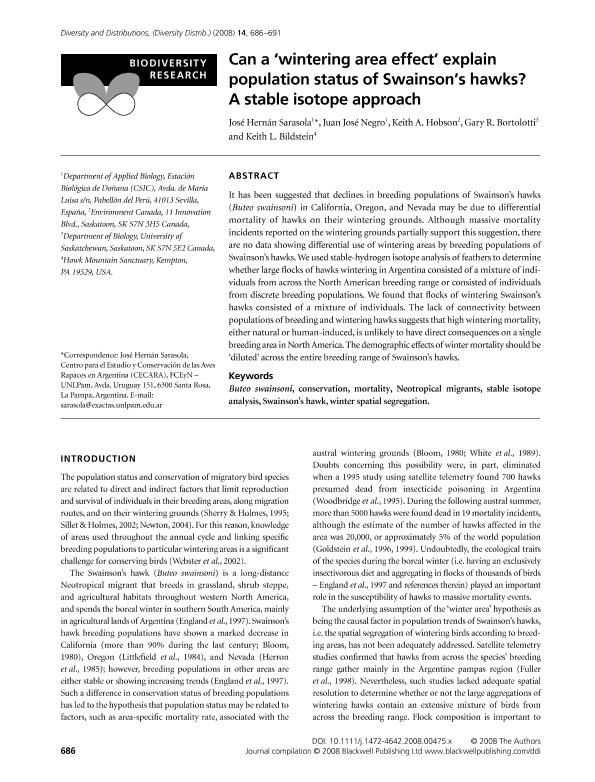Mostrar el registro sencillo del ítem
dc.contributor.author
Sarasola, José Hernán

dc.contributor.author
Negro Balmaseda, Juan José

dc.contributor.author
Hobson, Keith A.
dc.contributor.author
Bortolotti, Gary R.
dc.contributor.author
Bildstein, Keith

dc.date.available
2019-08-16T18:34:27Z
dc.date.issued
2008-07
dc.identifier.citation
Sarasola, José Hernán; Negro Balmaseda, Juan José; Hobson, Keith A.; Bortolotti, Gary R.; Bildstein, Keith; Can a 'wintering area effect' explain population status of Swainson's hawks? A stable isotope approach; Wiley Blackwell Publishing, Inc; Diversity and Distributions; 14; 4; 7-2008; 686-691
dc.identifier.issn
1366-9516
dc.identifier.uri
http://hdl.handle.net/11336/81745
dc.description.abstract
It has been suggested that declines in breeding populations of Swainson's hawks (Buteo swainsoni) in California, Oregon, and Nevada may be due to differential mortality of hawks on their wintering grounds. Although massive mortality incidents reported on the wintering grounds partially support this suggestion, there are no data showing differential use of wintering areas by breeding populations of Swainson's hawks. We used stable-hydrogen isotope analysis of feathers to determine whether large flocks of hawks wintering in Argentina consisted of a mixture of individuals from across the North American breeding range or consisted of individuals from discrete breeding populations. We found that flocks of wintering Swainson's hawks consisted of a mixture of individuals. The lack of connectivity between populations of breeding and wintering hawks suggests that high wintering mortality, either natural or human-induced, is unlikely to have direct consequences on a single breeding area in North America. The demographic effects of winter mortality should be 'diluted' across the entire breeding range of Swainson's hawks.
dc.format
application/pdf
dc.language.iso
eng
dc.publisher
Wiley Blackwell Publishing, Inc

dc.rights
info:eu-repo/semantics/openAccess
dc.rights.uri
https://creativecommons.org/licenses/by-nc-sa/2.5/ar/
dc.subject
Buteo Swainsoni
dc.subject
Conservation
dc.subject
Mortality
dc.subject
Neotropical Migrants
dc.subject
Stable Isotope Analysis
dc.subject
Swainson'S Hawk
dc.subject
Winter Spatial Segregation
dc.subject.classification
Zoología, Ornitología, Entomología, Etología

dc.subject.classification
Ciencias Biológicas

dc.subject.classification
CIENCIAS NATURALES Y EXACTAS

dc.title
Can a 'wintering area effect' explain population status of Swainson's hawks? A stable isotope approach
dc.type
info:eu-repo/semantics/article
dc.type
info:ar-repo/semantics/artículo
dc.type
info:eu-repo/semantics/publishedVersion
dc.date.updated
2019-08-15T16:23:14Z
dc.journal.volume
14
dc.journal.number
4
dc.journal.pagination
686-691
dc.journal.pais
Reino Unido

dc.journal.ciudad
Londres
dc.description.fil
Fil: Sarasola, José Hernán. Consejo Superior de Investigaciones Científicas; España. Consejo Nacional de Investigaciones Científicas y Técnicas. Instituto de Ciencias de la Tierra y Ambientales de La Pampa. Universidad Nacional de La Pampa. Facultad de Ciencias Exactas y Naturales. Instituto de Ciencias de la Tierra y Ambientales de La Pampa; Argentina
dc.description.fil
Fil: Negro Balmaseda, Juan José. Consejo Superior de Investigaciones Científicas; España
dc.description.fil
Fil: Hobson, Keith A.. Environment Canada; Canadá
dc.description.fil
Fil: Bortolotti, Gary R.. University of Saskatchewan; Canadá
dc.description.fil
Fil: Bildstein, Keith. Hawk Mountain Sanctuary; Estados Unidos
dc.journal.title
Diversity and Distributions

dc.relation.alternativeid
info:eu-repo/semantics/altIdentifier/url/https://onlinelibrary.wiley.com/doi/full/10.1111/j.1472-4642.2008.00475.x
dc.relation.alternativeid
info:eu-repo/semantics/altIdentifier/doi/https://doi.org/10.1111/j.1472-4642.2008.00475.x
Archivos asociados
